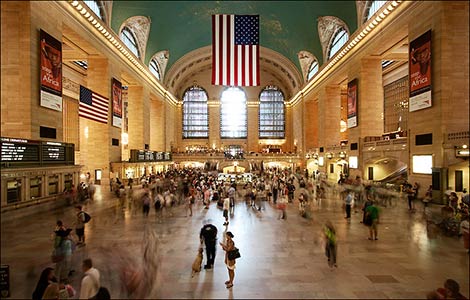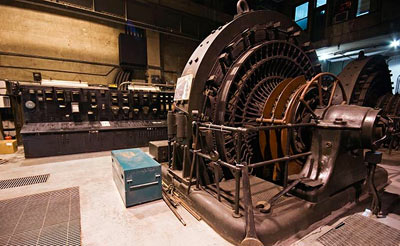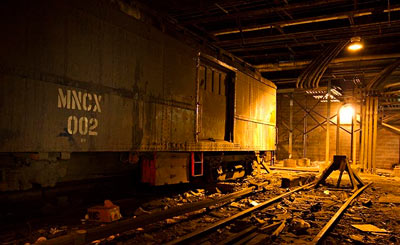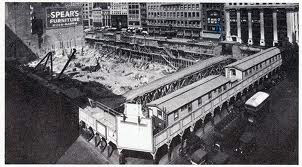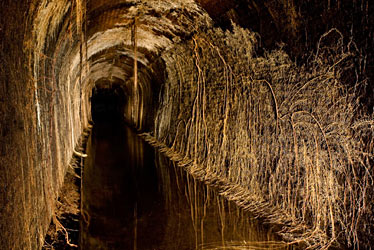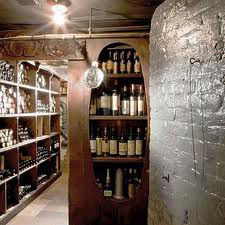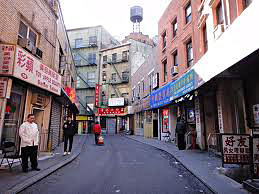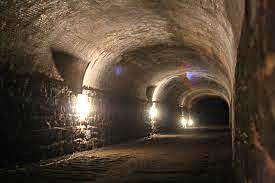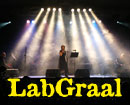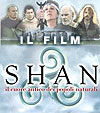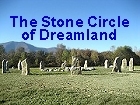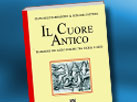| English Page |
Beneath the Streets |
 |
 |
| 08 November 2011 | ||||||||||||||||
New York as never seen before
What scenery comes to mind when you think about the Big Apple? Skyscrapers, Time Square, the Brooklyn Bridge, Central Park and all the other iconic places that make this city stand out in common imagination. However, the city bears another identity, one that is hidden under the feet of millions of people and beneath the streets of this towering megalopolis. Go to New York and you’ll never hear about this reality. Why? Well, because many of the city’s inhabitants just don’t know it even exists. Hidden tunnels, secret bases, buried rivers and who knows what else lurks in the dark claustrophobic bedrock of Manhattan. It really is no exaggeration at all to say that the overworld agglomeration has a dark sister that resides just a couple of flights down, and the things it contains make this city even more alluring and captivating. Grand Central Terminal New York has a vast underground subway system – the busiest in the U.S. – with 468 stations and 1,355 km of revenue and non-revenue tracks. Grand Central Terminal (a.k.a Grand Central Station), which opened back in 1913, serves as a transportation hub connecting train, metro, car and pedestrian traffic in an efficient way. It introduced electrical railway systems into the U.S. while the rest of the country still ran on steam.
The Terminal has 67 train tracks on two different levels. Entering the Beaux-arts style building leads you into the renowned concourse that is 470ft long, 160ft wide and 150ft high (143 x 49 x 43 meters). Visitors are often taken aback by the sheer size and magnificence of the structure that boasts statues of Minerva and Hercules, a zodiac painted vaulted ceiling, a grand western staircase designed after the old Paris opera house and 6 windows 23 meters tall. But what they don’t know is that beneath the current 44 platforms on two levels lies a secret base, one so well concealed that the access point in the Terminal is almost impossible to locate. Known as M42, this sub-basement was a super-secret level to the terminal that wasn’t on any of the design plans. Few people more than those who actually worked down there or those who built it knew of its existence. During WW2, if you were to find your way down to that level, without the proper clearance, you’d have been held there till the end of the war. Hitler came to know of its existence, though, and launched a plot to sabotage the AC to DC converters kept in the M42 by pouring bags of sand in them. This would have effectively crippled all troupe movement along the Eastern Seaboard. So, if you were caught holding bags of sand when those doors opened, you’d have been shot on sight. The CIA, however, was aware of the ploy, and the would-be saboteurs were caught before they could perpetrate their crime. The M42 is a large, cavernous room, nearly 3 stories tall and 10 stories below the Terminal. About half of the floor space along its main concourse holds the current converter grid, while the other half is dedicated to preserving the old machines, for the sake of history. The room is double the size of the upper concourse and is effectively located below sea level; therefore, pumps are constantly running to avoid any water buildup. The sub-basement also contains an old 1913 “electronic” train tracking system
The Secret Train Remerging top level and crossing a few streets brings you to an unassuming little side door at the Waldorf Astoria. Take a couple of long stair cases downward and you’ll find what was President Franklin Delano Roosvelt’s secret train platform below the Waldorf on Track 61. The area is quite disheveled, more like a construction site than anything that would reveal its rich history. Tracks ending, bare earth, partially finished wooden paths, bare cement and steel foundation works. You can hear commuter trains passing on nearby operational tracks just beyond a retainer wall. The drab space is oppressive. Sitting in this environment, quiet and unassuming, is an old rail car with the markings “MNCX 002”. There is debate whether this car, which featured gun ports, an over engineered body, and layered reinforced glass, actually belonged to the President. It is assumed that a track carried FDR from Washington to N.Y. at this secret station; and from there his limo would exit the train car onto an elevator that carried him up to the Waldorf. This way, he was never seen outside of his auto by the media, thus concealing the fact that he was bound to a wheelchair as a result of polio. Built on a River Strolling away from Grand Central Terminal and heading east towards West 34TH brings into view the most notable building of the city: the Empire State Building.
This landmark is a 102 floor monolith that opened in 1931 after neck snapping construction speed. Its observation decks offer an unparalleled view of the metropolitan area. Certainly, such a giant requires a solid foundation, and that’s what the Empire has. Its support columns sink into solid Manhattan bedrock for some 60 feet and anchor the skyscraper in place. What few know is that the building stands atop an old river that used to run in the plot of land formerly known as the Thomson Farm, which was sold at the end of the 1800s to make room for future development. At the start of 1930 digging began for the building’s foundations. Long columns were dug into the ground and bedrock and then explosives were lowered to excavate the area. The area had already undergone previous landscaping for other past structures such as the old hospital and Astor Mansion on 5th Ave; but erection of the Empire finally erased all traces of aboveground watercourses. In fact, the river located in that area now flowed below street level; and it can be correctly said that the Empire State Building is actually built on top of a river. Reinforced concrete and steel girders sink below ground to stabilize it all for a total of 6 sub-floors. The river flows on the last of these and pumps run around the clock to evacuate water, pumping it upwards to the N.Y. sewer circuit. Who would have ever though that a river would give leeway to modern architecture? Water water everywhere… Water also runs still runs along the Old Croton Aqueduct trail which was designed with an eye on Ancient Roman technology. In the 1820s and 30s the city suffered severe water shortage, thus leading to widespread disease and risk of fire. A solution was called for; and this solution came in the form of the Croton Aqueduct and upstate Damn. Before Central Park was built, the heart of Manhattan was the Receiving Reservoir of the Old Croton Aqueduct. Water was stored here before flowing to the Distributing Reservoir at 42nd Street. The 55-acre reservoir was as long as 6 city blocks and stretched between Sixth and Seventh Avenues. At its southwest corner, the reservoir's walls, instead of being cut blocks of stone, took advantage of the natural bedrock form. Belvedere Castle was built atop this point as an overlook.
Although the reservoir was filled in long ago, the Great Lawn still gives clues to this past history. Much of the north wall has been preserved as the retaining wall for the 86th Street Transverse. The Central Park Police are located at this spot now. Along the western edge of the Great Lawn, especially in the area across from the Delacorte Theater, the tops of the great stone walls can be seen. Access to the old Aqueduct can be gained at several access points, one of which is in the Bronx at West 119th. Today, the watercourse has been expanded with a series of parallel tunnels to allow for more flow capacity from upstate N.Y. A sip in the dark Think of the New York underground as a maze: mazes have dead-ends that do not lead anywhere. Well, the same goes for the underground excavations of the city, thing is that it’s a three dimensional labyrinth with nooks and crannies that were (and are) used for all sorts of purposes. One of these functional and creative uses took shape in the Roaring 1920s when Prohibitionism was enforced in the States. The many secret underground chambers were used to distill spirits and stash all sorts of alcohol since a ban was placed on drinking. A famous Midtown eatery known as Club 21 was one of the many Prohibition-era speakeasies where drinks were served out of federal sight. It catered to N.Y. city elite, who were all but ready to give up the booze. So, Club 21 devised a clever method of handling the situation. A guard kept watch at the upstairs entrance from behind a closed door and pressed a button whenever the feds were in the neighborhood. A signal went downstairs to the barkeep, who then pushed a second button to activate the bar’s rotating shelves that cast all bottles of wine and spirits down a chute into the sewers. The feds would enter the locale and see only the creme della creme wrapped up in mundane colloquialisms and gourmet savory treats.
No alcohol was ever found as the owners of the joint stashed everything in a secret chamber that was at the end of a dead-end hallway. A white brick wall with small little holes stood unassuming of its real purpose – a doorway to the stockroom. A skewer was slipped through a combination of holes and used as a key to unlock the entrance, which was composed of a solid steel vault door built into the brick wall itself. It was really heavy; but guarded the coveted goods with efficiency. Big Tunnels in Little Chinatown New York City is a haven of immigrants from all over world, who settled in small bordering neighborhoods. You had the Irish in Hell’s Kitchen, the Italians in Little Italy and the Chinese in Chinatown, to state a few. These last transplanted their culture into the New World, living in ways similar to those in China. Stepping into Chinatown quickly projects you into the Orient. Homes and shops are closely knit, wares and their sellers line the streets and winding alleys make you wonder about what lies just beyond the bend. Even to this day, it is perhaps the most notorious area of Manhattan. A world inside a world. So who ruled over this little world back in the days of mass immigration? In keeping with Chinese tradition an internal political structure comprised of the Chinese Consolidated Benevolent Association and various tongs/fraternal organizations, managed the opening of businesses, made funeral arrangements, and mediated disputes, among other responsibilities. An underground economy allowed undocumented laborers to work illegally without leaving the few blocks they called home. This whole structure gave rise to rumors of tunnels in Chinatown where people lived, and the “bodies” from gang wars are buried. The On Leong and Hip Sing tongs warred periodically through the early 1900s, waging bloody battles. Turf wars raged through Chinatown as factions of Tongs and Triads fought their brawls in the serpentine roads of the slums. Gunmen hid behind bends and ambushed the unwary.
However, the tunnels aren’t merely used to pile up victims of the street. Several investigations conducted by private investigation firms hired by independent journalists have revealed a hide-away community behind panels. Small shops on Canal and Doyers Streets, for example, seem to lead into these tunnels by removing either a wall panel or swinging open a trap door. Behind these dividers you’ll find the unexpected: Chinese laborers hard at work making counterfeit goods while in the bleakest working conditions, small tucked away casinos with a slew of gambling going on, black market shops with anything and everything. It is also estimated that thousands of illegal aliens also inhabit the dark recesses, living behind shopping arcades, walls and tunnels. To see Chinatown is to believe it. The Brooklyn choo-choo train Possibly the world’s oldest subway tunnel lurks beneath the streets of Brooklyn N.Y, right across the East River from Manhattan. Built in 1840 and not rediscovered until 1981, the Brooklyn tunnel runs under Atlantic Avenue in downtown Brooklyn and originally ran all the way to the port. The entrance to the tunnel is a manhole cover in the middle of busy Atlantic Ave There's currently a wall in the tunnel awaiting excavation, but for now the tour covers half a mile. Over 700 Irish immigrants built the tunnel in 7 months using the same methods the Romans used. This subway was most likely commissioned by the Masons of New York as a means of transport from Long Island given that at the time they were the highest ranking officials of the City. This subway, which was a steam engine, opened circa 1844, around 60 years earlier that the official NYC subway system went into operation and 20 years ahead of London’s tube.
And what else are we walking on? So what else is sealed within the darkness of the City? Consider that NYC was the entryway to the Colonies from the 1700s on; and also played a vital role in defending the United States as it rebelled against the Crown of England, further serving as guardian of the Northern States during the Revolution. Tunnels certainly connect the various outposts situated along NY Harbor to sneak in supplies inconspicuously, tunnels also run near the Brooklyn Bridge and were built in occasion of the Bridge’s foundations, abandoned subway tunnels and shafts span layers of the underground and are believed home to thousands of homeless known as “Mole People”. Going to New York, take the trouble of attempting to see one of these off-the-map sites (provided previous authorization); and it is guaranteed that you’ll long remember the experience.
|

